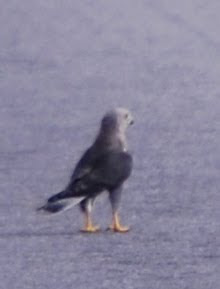
From: Brian Finch
THE ESTRILDA CHARMOSYNA CONUNDRUM ALONG THE SOUTH-EASTERN BORDER AREAS
WITH TANZANIA.
Dear All,
In Kenya, we are familiar with Black-faced Waxbill Estrilda
erythronotus, whereas for most of us we see Black-cheeked Waxbill
Estrilda charmosyna much less frequently, however this is the
widespread species, and it is erythronotus that has a restricted range
in this country. It is common around Nairobi all down to the Tanzanian
border (?), and likewise the distribution extends over the southern
border into the Maasai Mara and Tsavo (?).
Originally the two birds were treated as races of the same species,
although they were separated a long time ago now, but is it possible
that the complex includes a third species!?
I have attached photographs of charmosyna from Kongelai in NW Kenya,
Haberswein in NE Kenya, and Samburu in E Kenya. The most marked thing
about these birds when encountered is that they are so pale by
comparison with erythronotus, and lack red on belly and flanks,
although there is a pink tinge. So that when the birds are illustrated
from south of the equator towards the Tanzanian border areas of Tsavo
and Magadi Road, they are illustrated with the same dark plumage as
erythronotus. It is this that had led me (up to now) to think that
these records of charmosyna in southern Kenya have been mis-identified
or seen badly. As the colouration of the eastern/northern charmosyna
is so very different.
Having just visited Tsavo this past weekend, we located some waxbills
at Sagala Lodge and took photographs of the birds that were inhabiting
the Commiphora/Delonix/Acacia woodland. We were struggling to see a
black throat, on what looked superficially like erythronotus, and try
as we might, whilst the birds had a thin black line across the throat
at the base of the bill, the throat was pale. The birds were fairly
common (especially at owl-mobs), and once captivated by the presence
of an owlet remained confined to a small area and were easier to
study. As far as I know charmosyna is not recorded for Tanzania, but
this form must be found in the contiguous habitat that crosses the
border. (?)
I have attached an image of the typical erythronotus from Nairobi. The
black throat is very extensive and obvious, this is bordered by a
narrow whitish band that borders the lower part of the face patch and
continues across the throat. Overall the bird is dark toned, the
underparts reddish tinged grey across the belly and upper chest, a
deeper red band across the lower breast, striking red flanks, and
blackish lower belly to crissum.
A comparison of the photograph charmosyna (?) attached, that comes
from Sagala Lodge last Saturday, leads to many differences. The face
is black, but the throat is greyish, the birds share the white border
to the black face but this is restricted to the lower edge of the
face, but is absent on the black edge that borders the throat. The
underparts lack red, mainly buffy-grey on the upper chest, shading to
warm buff on the belly becoming paler towards the crissum. There are
no striking red-flanks. Above the two birds are very similar.
Checking the illustrations in Stevenson and Fanshawe, it became very
evident, that the erythronotus painting is incredibly awful, and not
looking anything like a Kenyan member of the species. The extent of
the black on the throat is virtually identical here in erythronotus
and charmosyna, and this poor representation will only lead to
confusion for anyone attempting to identify the species. The only
difference shown is dark as opposed to pale lower belly to undertail
coverts, and a subtle difference in flank colouration. I then examined
Zimmermann and Turner, where the differences were much better
illustrated, having used a bird resembling northern pale charmosyna,
although again the erythronotus isn’t very impressive as regards to
accuracy in colour it does at least show the extent of the black
throat.
Comparing my photographs of typical northern and eastern charmosyna
with these southern birds, many features are shared, absence of red on
chest and flanks, both with paler underparts than erythronotus, and
paler lower belly to undertail coverts, but the northern and eastern
birds show a very contrasting white throat and white forehead, as
opposed to greyish. They do not show any black line across the throat
at the base of the bill unlike the noticeable narrow black line of
southern charmosyna (?). Their lower belly/undertail coverts region is
much whiter, and overall the ground colouration is much paler.
Southern birds are robust and dark-hued, not as dark as erythronotus,
but nothing as pale as northern and eastern charmosyna, which also
appear smaller, and much slighter and delicate in the field. The
general appearance of southern charmosyna (?) is almost as robust as
erythronotus.
There is obviously a lot to learn about these three forms in Kenya,
the southern form of charmosyna (?) having never been described. With
the claim that dark charmosyna have occurred sympatrically with
erythronotus on the Magadi road, such studies can start on our
doorstep!
This is only a preliminary “wake-up” to make birders aware of the
interesting situation, wherever there is a “?” it means that now we
need confirmation of the record.
I have attached a selection of photographs of charmosyna from various
locations, I apologise for the standard, but they all tell the story.
It would be of interest if everyone could dig out their erythronotus
and charmosyna photographs and see what they have.
Please look carefully at all of the Black-faced/cheeked Waxbills met
with in this country, and in border areas with Tanzania, and report on
what form is where, and especially if there is any area of sympatry.
Best to all
Brian





 From: Brian Finch
From: Brian Finch














